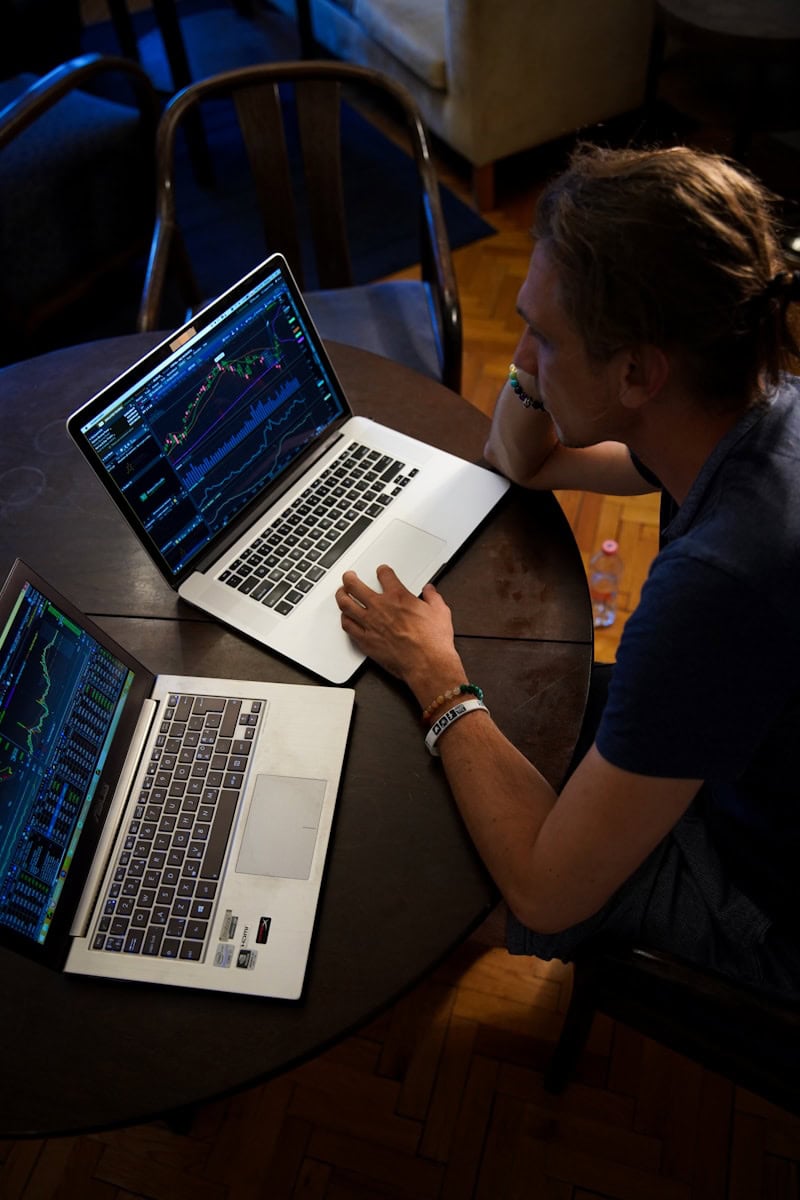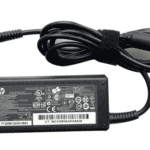Trading laptops play a key role for investors who need reliable technology. Choosing the right laptop can make a significant difference in trading success, with factors like processing power, screen quality, and reliability being crucial considerations. The right machine helps traders analyze markets, execute trades quickly, and manage multiple data streams at once.
Stock traders need computers that can handle demanding tasks without freezing or crashing. A good trading laptop must run multiple applications, display several charts, and process data in real-time. For day traders especially, even a few seconds of delay can mean the difference between profit and loss.
1. MacBook Pro 16-inch with M4 Chip
The MacBook Pro 16-inch with M4 chip stands as a top contender for serious traders. The latest model comes with either the M4 Pro or M4 Max chips, both designed specifically to handle intensive tasks.
For traders who need reliability during market hours, this machine delivers exceptional performance. The M4 chip processes complex trading applications and multiple charts without lag or freezing issues.
Battery life remains impressive even when running resource-heavy trading platforms. Traders can work through an entire trading session without hunting for a power outlet, a crucial feature for those who prefer mobility.
The 16-inch display offers ample screen space for monitoring multiple charts and indicators. Its high resolution ensures that fine details on candlestick patterns and trend lines remain sharp and clear.
Memory options start at 16GB, which many traders find perfectly sufficient for their needs. For more demanding setups with numerous applications running simultaneously, upgrades to higher RAM configurations are available.
Professional traders particularly value this machine for its reliability. According to trading experts, the MacBook Pro 16-inch ranks as the premier choice for those who prioritize dependable performance during critical market moments.
The built-in Apple Intelligence features help traders organize research and analyze market data more effectively. These tools integrate seamlessly with trading applications for a smoother workflow.
Connectivity options include Thunderbolt ports that support external monitors—an essential feature for traders who prefer multi-screen setups. The laptop easily connects to additional displays without performance compromises.
Price remains the main drawback, as this powerful trading machine commands a premium. However, many professional traders consider it a worthwhile investment given its performance and reliability advantages.
2. Lenovo ThinkPad T14
The Lenovo ThinkPad T14 stands out as a top choice for traders who need reliable performance throughout long market sessions. This business laptop combines power and practicality in a package designed for professionals.
With its Intel or AMD configuration options, the T14 handles multiple charts and trading platforms with ease. The latest models feature the Intel vPro platform, which adds an extra layer of security and manageability crucial for financial work.
Connectivity is a strong point for the T14. It comes equipped with blazing-fast WiFi and optional 4G capabilities, ensuring traders stay connected even in spotty internet environments.
Battery life impresses on the ThinkPad T14. Lenovo describes it as “epic,” making it suitable for traders who need to work away from power outlets during extended sessions.
Durability sets the T14 apart from consumer laptops. Each unit undergoes rigorous testing to meet military-grade standards, protecting your investment against everyday bumps and spills.
Security features are abundant through Lenovo’s ThinkShield. These protections keep sensitive financial data safe from prying eyes or potential breaches.
The display options satisfy most trading needs, with configurations that support crisp text and clear charts. Higher-end models offer improved color accuracy for traders who rely on visual indicators.
According to Reddit users, even the slim T14s variant proves “fine” for day trading activities. One user noted that “almost any laptop will do” but the ThinkPad’s business-like appearance adds a professional touch.
The latest ThinkPad T14 Gen 5 now includes AI-assisted productivity features that may help traders analyze market conditions more efficiently.
Upgradability remains a strength in most T14 models, allowing traders to extend their laptop’s useful life as requirements change over time.
3. Acer Aspire 5
The Acer Aspire 5 stands out as a dependable budget laptop for traders who want to save money for actual investments. Its balance of performance and affordability makes it an appealing choice for day traders who need reliable equipment without breaking the bank.
This versatile laptop comes equipped with 13th Gen Intel Core processors and NVIDIA graphics, providing accelerated multitasking capabilities whether you’re working from home or on the go. The processing power handles multiple trading platforms and financial analysis tools with ease.
The 15.6-inch Full HD IPS display offers clear visuals for chart analysis and market monitoring. Traders will appreciate the screen clarity when tracking multiple stocks or currency pairs simultaneously.
Users report positive long-term experiences with the Aspire 5. One owner mentioned they purchased their model in 2019 and found it suitable for both office work and gaming, suggesting it has the staying power traders need for demanding software.
The backlit keyboard adds functionality for traders who often work in varying light conditions or during early morning market openings. This feature proves especially useful during pre-market sessions that start before sunrise.
Battery life meets expectations for a trading laptop, allowing for moderate use throughout a trading day. However, during high-intensity trading sessions, keeping the charger handy remains a wise practice.
Storage options typically include SSD configurations, with some models offering 128GB capacity. While this storage capacity works for basic trading setups, power users might consider upgrading for additional space to store historical market data.
The Aspire 5’s price point represents its main advantage. Traders can allocate more capital toward actual trading rather than equipment costs, making it a smart choice for beginners or budget-conscious professionals.
4. Falcon F-52GT Trading Computer
The Falcon F-52GT is widely recognized as a powerful trading computer designed specifically for serious investors. It combines high performance with reliability, making it suitable for traders who need to run multiple applications simultaneously.
Many traders consider the F-52GT to be the most popular choice among Falcon’s lineup of trading computers. The system is built with speed in mind, offering quick processing for real-time market data analysis.
One key advantage of the F-52GT is its multi-monitor support capability. This feature allows traders to view different markets, charts, and news feeds all at once without switching between tabs.
The computer comes equipped with the latest technology aimed at reducing latency and system crashes. This stability is crucial during volatile market conditions when split-second decisions can impact trading outcomes.
While primarily marketed as a desktop solution, the F-52GT offers more power than most portable trading systems. It represents a middle ground between ultra-portable laptops and full trading stations.
Price-conscious traders should note that the F-52GT sits at a premium price point. Some trading forums mention prices starting around $3,600 for basic configurations, reflecting its specialized nature.
The system earns positive mentions for its durability. Many traders report using their F-52GT computers for several years without significant performance degradation, making it a long-term investment.
Customer reviews highlight the computer’s quiet operation despite its powerful components. This feature proves beneficial during long trading sessions where noise can become distracting.
Trading software compatibility is another strength of the F-52GT. The system handles resource-intensive charting programs and trading platforms with minimal lag, contributing to its reputation for reliability.
5. Apple MacBook Air M3
The Apple MacBook Air with the M3 chip stands out as a strong option for traders who need portability without sacrificing performance. This thin and lightweight laptop packs serious power for its size, making it suitable for running multiple trading applications simultaneously.
For day traders, the MacBook Air M3 can handle many trading view tabs and lots of Safari windows while keeping other programs like Spotify running in the background. Its processing capability allows for smooth multitasking without frustrating slowdowns.
Battery life is another major advantage. Traders can work for extended periods without hunting for power outlets. This feature proves especially valuable for those who prefer trading from different locations throughout the day.
The display quality on the MacBook Air M3 delivers sharp visuals for chart analysis and market data. Colors appear accurate and text remains crisp, reducing eye strain during long trading sessions.
Many users praise the M3 Air for its smooth operation and user-friendly interface. The intuitive macOS system makes navigating between different trading platforms and research tools effortless.
Price-wise, the MacBook Air M3 sits in a sweet spot. It offers substantial computing power at a more affordable price point than the Pro models, making it accessible for traders who need performance without the premium cost.
Some traders even consider trading in their MacBook Pro models for the Air M3, especially if they primarily use their computer for trading, writing, and internet browsing.
The base model comes with 8GB of memory, which works for casual trading. However, serious day traders should consider upgrading to 16GB for smoother performance when running multiple resource-intensive applications.
Storage options begin at 256GB, adequate for most trading software, though additional cloud storage might be necessary for traders who store large amounts of historical data.
6. Asus Zenbook S 16
The Asus Zenbook S 16 stands out as a powerful option for traders who need both performance and portability. This laptop features an ultra-slim design that doesn’t compromise on power.
At the heart of this machine is the AMD Ryzen AI 9 processor, which provides exceptional computing capabilities for running multiple trading platforms and analysis tools simultaneously. The dedicated AI NPU (Neural Processing Unit) gives this laptop unmatched AI capabilities that can help with predictive analysis and pattern recognition.
Traders will appreciate the stunning 16-inch 3K OLED display. The high resolution and vibrant colors make charts, graphs, and market data easy to read even during long trading sessions. The touch screen functionality adds another dimension of control for quick interactions.
Memory isn’t an issue with the Zenbook S 16. It comes with 24GB of DDR5 RAM, ensuring smooth multitasking when running resource-intensive trading software. The 1TB SSD provides fast data access and plenty of storage for historical market data.
Battery life is crucial for traders who work on the go. This laptop features a battery with enough capacity to last through marathon trading sessions without needing to constantly search for power outlets.
For traders who also work with visual data or create content, the Zenbook S 16 is NVIDIA Studio-validated with GeForce RTX 4060 graphics. This makes it suitable for running advanced visualization tools and rendering complex market models.
The improved trackpad features common sense improvements that make navigation faster and more intuitive. This small but significant upgrade can make a difference during fast-paced trading sessions when every second counts.
Weighing in as a lightweight and powerful laptop, the Zenbook S 16 balances portability with performance. This makes it perfect for traders who move between home, office, and client meetings.
7. Dell XPS 15
The Dell XPS 15 stands out as a top choice for traders who need a blend of power and portability. This premium laptop features a stunning display with slim bezels that maximize screen space while keeping the overall footprint compact.
Under the hood, the XPS 15 packs impressive hardware that can handle multiple trading platforms and data streams simultaneously. Many traders consider it the benchmark of laptops due to its reliable performance during market hours.
The laptop’s build quality adds to its appeal. Made with premium materials and precision-cut components, it offers both durability and a lightweight design that traders appreciate when moving between home, office, or coffee shops.
Battery life on the XPS 15 is substantial enough for most trading sessions, though intensive use will require a power outlet nearby. Its cooling system manages heat effectively during extended trading periods when processing power demand remains high.
Connectivity options abound with multiple ports for external monitors—a crucial feature for traders who rely on multi-screen setups to track various markets. The backlit keyboard proves useful during early morning or late-night trading sessions.
For traders who travel frequently, the XPS 15 strikes an excellent balance between screen size and portability. It’s featured prominently in 2024 reviews of best trading laptops, highlighting its suitability for serious market participants.
The crisp, color-accurate display helps traders spot subtle patterns in charts and graphs. With quick boot times and responsive performance, this laptop minimizes delays when executing time-sensitive trades.
Though not the cheapest option, the XPS 15 represents a sound investment for traders who depend on their equipment for their livelihood. Its combination of power, display quality, and build makes it a standout option in the trading laptop market.
8. Lenovo ThinkPad X1 Extreme
The Lenovo ThinkPad X1 Extreme stands out as a powerful option for traders who need serious computing muscle. This business laptop combines high performance with the reliability ThinkPad is known for.
With support for up to four independent monitors, the X1 Extreme makes working with complex computations and day trading much easier. Traders can view multiple charts, data feeds, and trading platforms simultaneously without lag.
The latest models feature Intel Core i7 processors paired with NVIDIA discrete graphics. This combination handles demanding trading software and data analysis tools with ease.
Build quality remains a standout feature. Users report excellent workmanship and a very sturdy machine that holds up to daily use. The laptop doesn’t overheat even during intensive tasks, which matters when running trading applications for hours.
Memory and storage options are trader-friendly. The X1 Extreme offers upgradeable RAM, allowing traders to start with a basic configuration and add more memory as their needs grow.
The laptop balances power with portability. While not ultralight, it remains relatively light compared to other trading-capable machines. Traders who move between home and office will appreciate this mobility.
Battery life is adequate for a high-performance machine, though traders should keep the power brick handy for extended sessions. Some users note the charger is oversized, a minor inconvenience for the performance gained.
The 16-inch display on newer models provides ample screen real estate for charts and trading interfaces. The Gen 5 model specifically comes with an Intel Core i7-12800H processor and 16GB RAM as standard, making it a strong contender for traders seeking a desktop replacement.
9. Gladiator X14 EZ Trading Computer
The Gladiator X14 EZ Trading Computer stands out as a top choice for serious stock traders. Priced at $3,099, it’s considered the #1 pick by many trading experts for its exceptional performance.
This powerhouse machine features the Intel Core i9-14900K processor, making it one of the fastest trading computers available. The system comes ready for AI-trading applications, which is becoming increasingly important for modern traders.
For graphics processing, the Gladiator X14 includes an Nvidia RTX 4060 card. This ensures smooth chart rendering and flawless multi-monitor support—essential features when tracking multiple stocks simultaneously.
Reliability matters when your money is on the line. The Gladiator X14 comes with a impressive 5-year warranty and lifetime technical support, giving traders peace of mind during critical market moments.
The computer ships with ample memory and storage. It includes 32GB of RAM and a 1TB solid-state drive at no extra cost, providing the speed and space needed for running multiple trading platforms.
Precision real-time data handling is another key benefit. The system is specifically optimized for fast order execution, which can make the difference between profit and loss in fast-moving markets.
Built by EZ Trading Computers, the Gladiator X14 was designed by traders for traders. The company was founded by Eddie Z, known as both a Wall Street trader and computer expert, so the machine addresses the specific needs of the trading community.
For day traders who can’t afford system crashes or slowdowns during market hours, this computer delivers exceptional stability and performance when it matters most.
10. Orbital Silenced x2000
The Orbital Silenced x2000 stands out in the trading computer market for its exceptional noise control features. Traders who need quiet working conditions will appreciate its careful design focused on minimizing sound distractions.
This powerful machine uses Fractal Design cases with sound-dampening materials on the internal panels. These materials work to absorb and reduce operational noise that typically bothers traders during long sessions.
The system comes equipped with an Intel Core i9 14900KF CPU that reaches speeds up to 6.00 GHz. This processing power handles multiple trading platforms and real-time market data without lag or slowdowns.
What makes this computer truly special is its cooling system. The x2000 features Austrian-designed Noctua fans, widely considered among the best for balancing cooling performance with whisper-quiet operation.
Power supply noise is another common problem the x2000 addresses. It uses silent series power supplies with fanless modes that eliminate another potential source of distraction when the system isn’t under heavy load.
Price-wise, the Silenced x2000 sits at around $2,611 through special offers. While not the cheapest option, traders often find the investment worthwhile for the performance and sound benefits.
The combination of high-end components and noise reduction makes this computer particularly suitable for day traders who need both power and concentration. Many consider it the quietest trading computer available today.
For serious traders, this machine competes directly with other high-performance trading computers like the Radical X13. The difference comes down to whether noise reduction matters more than raw performance metrics.
Key Features to Consider
When choosing a trading laptop, specific hardware elements will make a significant difference in your day-to-day experience. The right combination of features ensures smooth operation during market hours.
Processor and Performance
The processor serves as the brain of your trading laptop, handling all calculations and operations. For trading, you’ll want at least an 11th generation Intel Core i5 or AMD Ryzen 5 processor. However, 16GB RAM is considered the minimum for smooth multitasking across multiple platforms and charts.
Look for these processor specifications:
- Clock speed: At least 3.0 GHz
- Cores: Minimum 4 cores, 6+ cores preferred
- Cache: Larger cache (8MB+) improves performance
Storage type matters too. An SSD (solid-state drive) is essential—512GB or larger for quick data access. This allows your trading platforms to load faster and reduces lag when switching between applications.
RAM expansion slots are valuable for future upgrades as your trading needs grow.
Graphics Capabilities
While high-end gaming graphics aren’t necessary for most traders, decent graphics processing helps with chart rendering and multi-monitor setups. Integrated graphics like Intel Iris Xe or AMD Radeon Vega are generally sufficient for most trading activities.
Key graphics considerations include:
- Display quality: Full HD (1920×1080) minimum resolution
- Multi-monitor support: Check ports (HDMI, DisplayPort, USB-C)
- Color accuracy: Important for reading charts correctly
For traders using intensive technical analysis software or running 4+ monitors, a dedicated GPU from NVIDIA or AMD provides better performance. Look for at least 4GB VRAM if you go this route.
Screen size and quality also matter—a 15.6″ display offers good balance between workspace and portability.
Battery Life and Portability
Trading often requires mobility, making battery life and build quality important factors. Look for laptops offering 8+ hours of real-world battery performance, especially if you trade away from your desk.
Weight considerations:
- Ultralight: Under 3 lbs (best for frequent travelers)
- Standard: 3-4.5 lbs (good balance)
- Desktop replacement: 5+ lbs (prioritizes performance over portability)
Build quality affects longevity and resistance to daily wear. Aluminum chassis laptops typically offer better durability than plastic models.
Heat management is crucial for sustained performance. Look for laptops with effective cooling systems, especially if you plan to run trading platforms for extended periods. Poor thermal management can lead to throttling—when your laptop slows down to prevent overheating.
Optimizing Your Laptop for Trading
Getting the most out of your trading laptop requires careful setup beyond just hardware specifications. The right software configuration and network setup can make a significant difference in your trading performance.
Software Compatibility
Trading platforms have specific requirements that can impact performance. Most trading software works best with Windows operating systems, though some platforms offer Mac compatibility.
Before installation, check the minimum RAM requirements for your trading platform. Many modern platforms need at least 8GB RAM, but 16GB provides better multitasking capabilities when running multiple applications.
Consider these software optimization tips:
- Disable unnecessary startup programs to reduce system load
- Update graphics drivers regularly for better multi-monitor support
- Install trading-specific antivirus solutions that won’t interrupt during market hours
- Use virtual desktop software to organize different trading setups
Keep your operating system updated but be cautious about major updates during trading hours. Some traders create system restore points before trading days to quickly recover from software issues.
Network Connectivity and Speed
A stable internet connection is non-negotiable for trading. Fiber connections offer the best speed and stability, though cable connections can suffice with proper setup.
Many serious traders use dual internet connections from different providers as backup. This redundancy prevents missing opportunities during outages.
Wi-Fi can work for trading but introduces latency risks. If using wireless, ensure:
- Position your laptop near the router
- Use 5GHz bands instead of 2.4GHz for less interference
- Consider a dedicated trading Wi-Fi network
Network speed matters less than stability and latency. Test your connection using ping tests to trading servers rather than standard speed tests. Latency under 30ms is ideal for most trading activities.
Trading laptops with built-in ethernet ports provide more reliable connections than USB adapters. For those traveling frequently, investing in a mobile hotspot with unlimited data creates a personal trading network anywhere.
Frequently Asked Questions
Traders need specific laptop features for optimal performance during market hours. Technical requirements vary based on trading style, software needs, and budget constraints.
What are the key features to look for in a laptop suitable for stock trading?
For stock trading, focus on processing power and display quality. Look for a minimum of 8GB RAM, but 16GB or higher is preferable for running multiple trading platforms.
A multi-core processor (Intel i7/i9 or AMD Ryzen 7/9) handles chart analysis and real-time data processing efficiently. For serious traders, the MacBook Pro with the M4 chip offers excellent performance.
Screen resolution matters – choose at least Full HD (1920×1080) with good color accuracy. Many traders prefer larger screens (15-16 inches) or connect to external monitors.
How do I choose a laptop for forex trading that offers optimal performance?
Forex traders need laptops with excellent reliability and battery life. The ThinkPad series is popular among forex traders for its durability and keyboard quality.
Battery life becomes crucial during volatile trading sessions. Look for laptops offering 8+ hours of real-world usage.
Internet connectivity is vital for forex trading. Choose laptops with reliable Wi-Fi 6 capability and an Ethernet port option for backup connections.
What are the most recommended laptops for crypto trading in the current market?
Crypto traders benefit from high-performance laptops that can handle intensive calculations. The MacBook Pro 16-inch with M4 chip excels at multitasking while running resource-heavy applications.
For Windows users, the Lenovo ThinkPad T14 offers a good balance of performance and reliability. Many crypto traders also consider the Falcon F-52GT for its specialized trading specifications.
Storage speed matters for crypto trading applications – NVMe SSDs provide the fastest data access speeds currently available.
Can you suggest budget-friendly laptops that are efficient for trading activities?
The Acer Aspire 5 offers excellent value with decent specs for beginning traders. It provides adequate performance without breaking the bank.
Research your trading platform’s minimum requirements before purchasing a budget laptop. Most platforms run well on mid-range hardware.
Consider last-generation models of premium laptops, which often sell at significant discounts while maintaining solid performance for trading tasks.
What advantages do laptops have over desktop computers for traders?
Laptops offer mobility that desktops can’t match. Traders can work from different locations or continue monitoring positions while traveling.
The choice between desktop and laptop depends on your trading style. Day traders who work from a fixed location might prefer desktops, while swing traders value laptop flexibility.
Modern high-end laptops like the MacBook Air M3 now provide enough power for most trading activities while maintaining portability.
How important are processing speed and memory for trading on a laptop?
Processing speed directly impacts how quickly your trading platform responds to inputs. Fast processors minimize lag when analyzing charts or executing trades during volatile market conditions.
RAM capacity determines how many applications you can run simultaneously. Most trading setups require multiple programs running at once – trading platforms, browsers, spreadsheets, and communication tools.
For serious traders, investing in higher specs pays off through smoother operation during critical trading moments. The difference between 8GB and 16GB RAM can be significant when market activity peaks.







